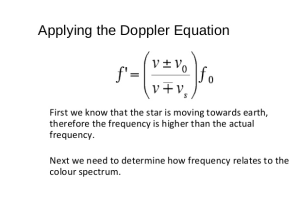

Similarly, the observer on the left receives a longer wavelength, and hence he hears a lower frequency. Because the observer on the right in case (b) receives a shorter wavelength, the frequency she receives must be higher. The sound moves in a medium and has the same speed v in that medium whether the source is moving or not. We know that wavelength and frequency are related by v = f λ , where v is the fixed speed of sound. The observer moving toward the source receives them at a higher frequency, and the person moving away from the source receives them at a lower frequency. Finally, if the observers move, as in case (c), the frequency at which they receive the compressions changes. Thus, the wavelength is shorter in the direction the source is moving (on the right in case b), and longer in the opposite direction (on the left in case b). This moving emission point causes the air compressions to be closer together on one side and farther apart on the other. Each compression of the air moves out in a sphere from the point at which it was emitted, but the point of emission moves. If the source is moving, the situation is different. If the source is stationary, then all of the spheres representing the air compressions in the sound wave are centered on the same point, and the stationary observers on either side hear the same wavelength and frequency as emitted by the source (case a). Each disturbance spreads out spherically from the point at which the sound is emitted. What causes the Doppler shift? The figure below illustrates sound waves emitted by stationary and moving sources in a stationary air mass.

The Doppler effect is an alteration in the observed frequency of a sound due to motion of either the source or the observer. (U is negative because it's towards the source).Doppler’s effect explains the perceived increase (or decrease) in the frequency of sound, light, or other waves as the source and observer move toward (or away from) each other. If a source moving toward the observer raises the frequency heard by the observer by decreasing the wavelength of the sound in the denominator which is given by:-īut if an observer moves toward the source, it increases the frequency heard by increasing the relative velocity between him and the sound wave in the numerator. How doppler effect is used to calculate the relative velocity:. Where c is the velocity of radio waves in the medium, vT is the velocity of the receiver with respect to the medium and vs is the velocity of the source with respect to the medium. In Doppler effect, the relationship between the received frequency f and the transmitted frequency f0 is given by:. The distance between successive wave fronts is then increased, so the waves spread out. Conversely, if the source of waves is moving away from the observer, each wave is emitted from a position farther from the observer than the previous wave, so the arrival time between successive waves is increased, reducing the frequency. While they are traveling, the distance between successive wave fronts is reduced, so the waves "bunch together". Hence, the time between the arrivals of successive wave crests at the observer is reduced, causing an increase in the frequency. Therefore, each wave takes slightly less time to reach the observer than the previous wave. The main reason for the Doppler effect is that when the source of the waves is moving towards the observer, each successive wave crest is emitted from a position closer to the observer than the crest of the previous wave. ThisĮffect is readily observable as variation in the pitch of soundīetween a moving source and a stationary observer. Or decreasing the distance between the source and the receiver. The Doppler effect causes the received frequency of a source toĭiffer from the sent frequency if there is motion that is increasing When theįixed-frequency radio wave sent from the sender continuously strikesĪn object that is moving towards or away from the sender, theįrequency of the reflected radio wave will be changed. Doppler effect is used to measure speed in RADAR sensors.


 0 kommentar(er)
0 kommentar(er)
